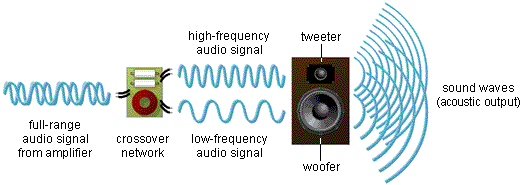crossover network

A crossover network, also called a dividing network, is the component of a loudspeaker that divides the audio signal between the drivers. Most speakers must use more than one size of driver because it is extremely difficult for one driver to accurately reproduce sound waves over the entire 20 Hz to 20 kHz frequency range of human hearing. The most common multi-way speakers use two drivers, a tweeter and a woofer. This requires the electrical audio signal to be divided into a high-frequency part and a low-frequency part before the signals reach the drivers. This is very important because most tweeters will be damaged if they are driven with a low-frequency signal. The illustration below shows the sound being divided between the tweeter and the woofer:
The frequency where the sound is divided is called the crossover frequency. Ideally, a crossover frequency is chosen which protects the tweeter, allowing it to produce only those frequencies that it can reproduce the best, and allows both the response and coverage pattern of the woofer to blend well with the tweeter. The coverage pattern is the shape of the listening area where a driver will provide a relatively uniform direct sound pressure level.
If the speaker has more than two sizes of drivers the crossover network also divide the audio signal into one or more additional midrange frequency bands.
There are two places where a crossover network can be placed in the audio system: after the amplifier or before the amplifier. Here are some points about each location:
After the amplifier
Before the amplifier
The important point to remember about crossover networks is that they divide the audio signal so that each driver in a multi-way speaker will receive only frequencies that it can handle and reproduce well.


